Information Library
Start Reading

When a tooth lacks stability, a dental crown can restore its appearance, size, and strength. Dental crowns protect the tooth after procedures such as a root canal, dental bridge, or dental implant. Patients may also get a crown to cover a damaged or discolored tooth or support a decay-weakened tooth.
If you think you might need a crown, you’re not alone. Single crown placement is the most common restorative procedure performed in the U.S.! Keep reading to learn the types of dental crowns and cost of different styles.
 Typically, full porcelain or ceramic crowns are used on the most visible teeth. These two options allow the dentist to choose a shade that closely resembles your teeth. Full porcelain and ceramic crowns closely resemble your natural teeth, making them a popular choice, especially for front teeth. On the other hand, the material is weaker than others, like gold.
Typically, full porcelain or ceramic crowns are used on the most visible teeth. These two options allow the dentist to choose a shade that closely resembles your teeth. Full porcelain and ceramic crowns closely resemble your natural teeth, making them a popular choice, especially for front teeth. On the other hand, the material is weaker than others, like gold.
Next to full porcelain or ceramic crowns, porcelain-fused-to-metal is the most natural-looking option. These crowns have a metal structure covered by porcelain, making them more durable than an all-porcelain crown. This combination of materials makes the dental crown a strong yet natural-looking choice. One potential disadvantage, however, is that receding gums can reveal the underlying metal as a dark line next to the gums.
Dental crowns for molars are made from a gold alloy (a mixture with other metals). Gold has the best longevity of any crown material and will rarely break. This makes it preferable for molars, which need to be durable to bite and chew hard foods. Additionally, while gold crowns are obvious in the front of the mouth, their use for molars makes them less visible.
Gold crowns are also the best option for people with TMJ or bruxism, as these conditions put more pressure on the teeth. Over time, pressure on the teeth can cause the gum to recede and expose parts of the tooth root to plaque.
Temporary dental crowns are made from stainless steel. This type of crown is a prefabricated piece placed on a tooth as a short-term measure. The crown protects the teeth while the permanent crown is made from another material.
Stainless steel is the most common material used for pediatric dental crowns, which protects baby teeth from decay until the adult teeth come in. Once the tooth comes out, the stainless steel crown will fall out naturally. The other advantage is that it doesn’t require multiple dental visits to put in place.
The types of dental crowns and cost to place them are highly dependent on your particular dental needs. Three major factors will affect the cost of any dental crown:
them are highly dependent on your particular dental needs. Three major factors will affect the cost of any dental crown:
Ready for your affordable dental crown? To learn more about the types of dental crowns and costs at Penn Dental Medicine, or to schedule a crown consultation, click here or please call us at 215-898-8965!